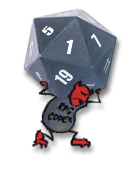You get used to it, but in principle at least I find it slightly obnoxious. Two upsides are that it feels a little more "old-school" than your usual modern 4k top-down game that has lots of teeny-tiny shit going on everyplace, and I suppose it also slightly reduces load on the GPU. It does also accentuate the need for experience with the game and situational awareness.
The downsides are obvious. You can't see as far, so analyzing the whole of surrounding terrain is more difficult (the map overlay helps but adds visual noise), and you can't analyze enemies until they're quite close or attack them from too far off (some ranged abilities that don't require direct clicking can reach offscreen if you know they're there; others can't). The effect is slightly more pronounced in the corners of the screen, where you'll have unnecessarily huge health and mana globes, your buff/debuff bar, and your minimap/quest tracker. You can't modify the UI or client in any way, either, on pain of being banned.
I will say however that unlike all of the other 3D Diablo clones (Titan Quest, Torchlight/II, Grim Dawn, World of Diablocraft 3, etc.), GGG managed to somehow employ a form of quasi-orthographic projection/near-true isometry in PoE. What I mean by that is that normally, when you take a 3D game and simply move and fix the camera viewpoint to simulate a traditional zoomed-out 2D isometric/top-down view, there is no
orthographic projection effect. You'll therefore be able to see more terrain at the top of the screen, but less at the bottom, so that your character has a restricted view in that direction regardless of facing. The middle bottom of the screen will be very restricted.
If you've ever played Torchlight II, you surely know what I mean. You can see much further walking "up" or "north" than "down" or "south," meaning nasty enemies can more easily surprise you from the bottom-of-screen direction.
PoE's view is actually somewhat balanced across all directions. It's possible that PoE's restricted view is actually a product or part of the quasi-orthographic projection effect.















